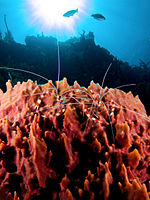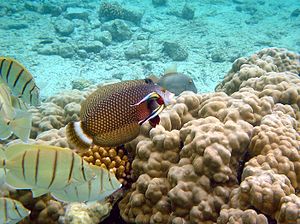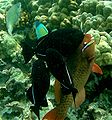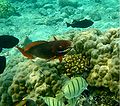- Cleaning station
-
A rockmover wrasse Novaculichthys taeniourus being cleaned by Hawaiian cleaner wrasses, Labroides phthirophagus on a reef in Hawaii. Some manini and a filefish wait their turn.

 Stenopus hispidus banded cleaner shrimp on a Xestospongia muta barrel sponge. The shrimp wait to remove external parasites and dead skin from visiting fish clients.
Stenopus hispidus banded cleaner shrimp on a Xestospongia muta barrel sponge. The shrimp wait to remove external parasites and dead skin from visiting fish clients.
A cleaning station is a location where fish, sea turtles, hippo and other aquatic life, freshwater and marine, congregate to be cleaned.
The cleaning process includes the removal of parasites from the animal's body (both externally and internally), and can be performed by various creatures (including cleaner shrimp and numerous species of cleaner fish, especially wrasses and gobies).
When the animal approaches a cleaning station it will open its mouth wide or position its body in such a way as to signal that it needs cleaning. The cleaner fish will then remove and eat the parasites from the skin, even swimming into the mouth and gills of any fish being cleaned.
Cleaning stations may be associated with coral reefs, located either on top of a coral head or in a slot between two outcroppings. Other cleaning stations may be located under large clumps of floating seaweed or at an accepted point in a river or lagoon.
A number of fish species mimic the appearance and behaviour of cleaners, then tear away scales or flesh when suitably close to the victim.
Humans are beginning to make use of this tendency of certain fish species to remove dead skin. Spas for fish pedicures and whole body treatments have become globally fashionable.[citation needed]
References
- Animal Communication Networks, Page 525, By Peter K. McGregor, Published by Cambridge University Press
Related articles
Gallery
-
A parrotfish being cleaned by Hawaiian cleaner wrasses, Labroides phthirophagus (photographed in 2005 in Hawaii)
-
A parrotfish being cleaned by Hawaiian cleaner wrasses, Labroides phthirophagus (photographed in 2005 in Hawaii)
-
A needlefish being cleaned by Hawaiian cleaner wrasses, Labroides phthirophagus
-
A needlefish being cleaned by Hawaiian cleaner wrasses, Labroides phthirophagus
-
A Hawaiian cleaner wrasse, Labroides phthirophagus inside the gill of a pufferfish
Categories:
Wikimedia Foundation. 2010.









